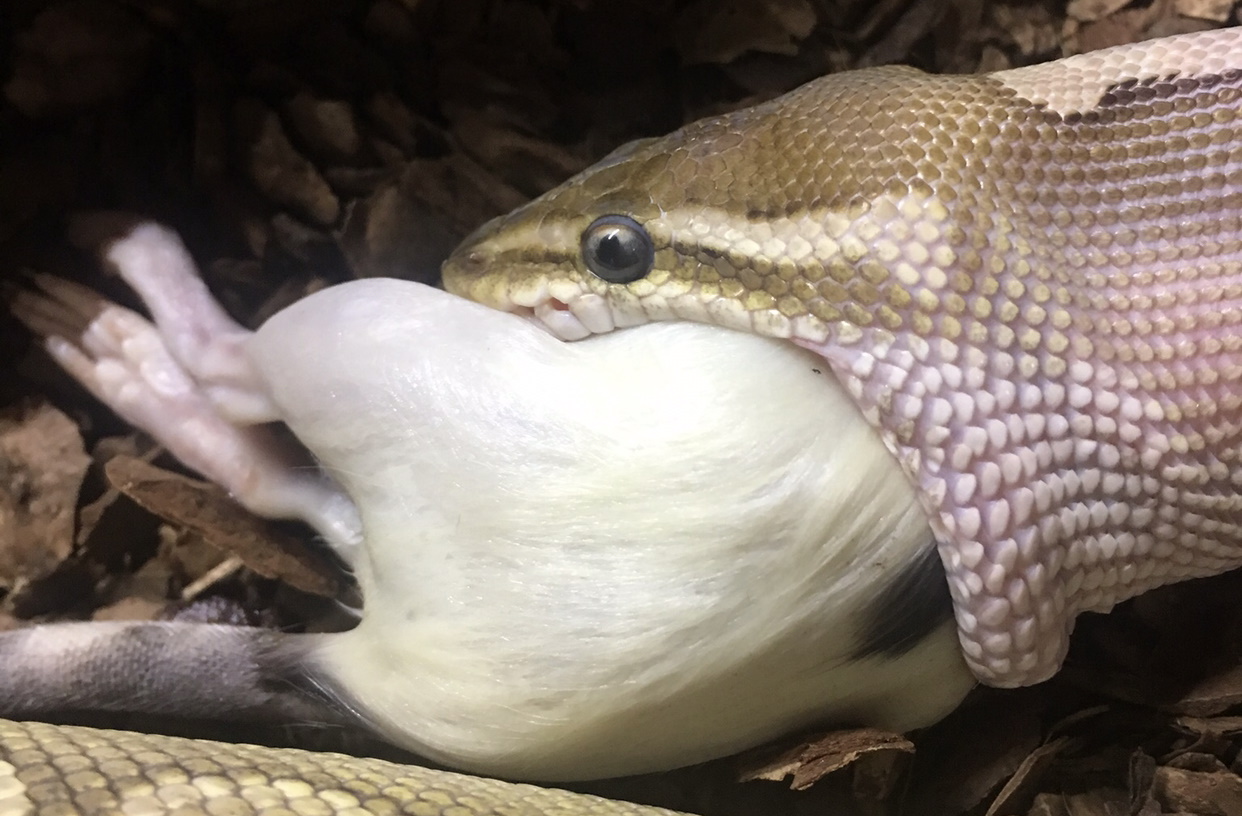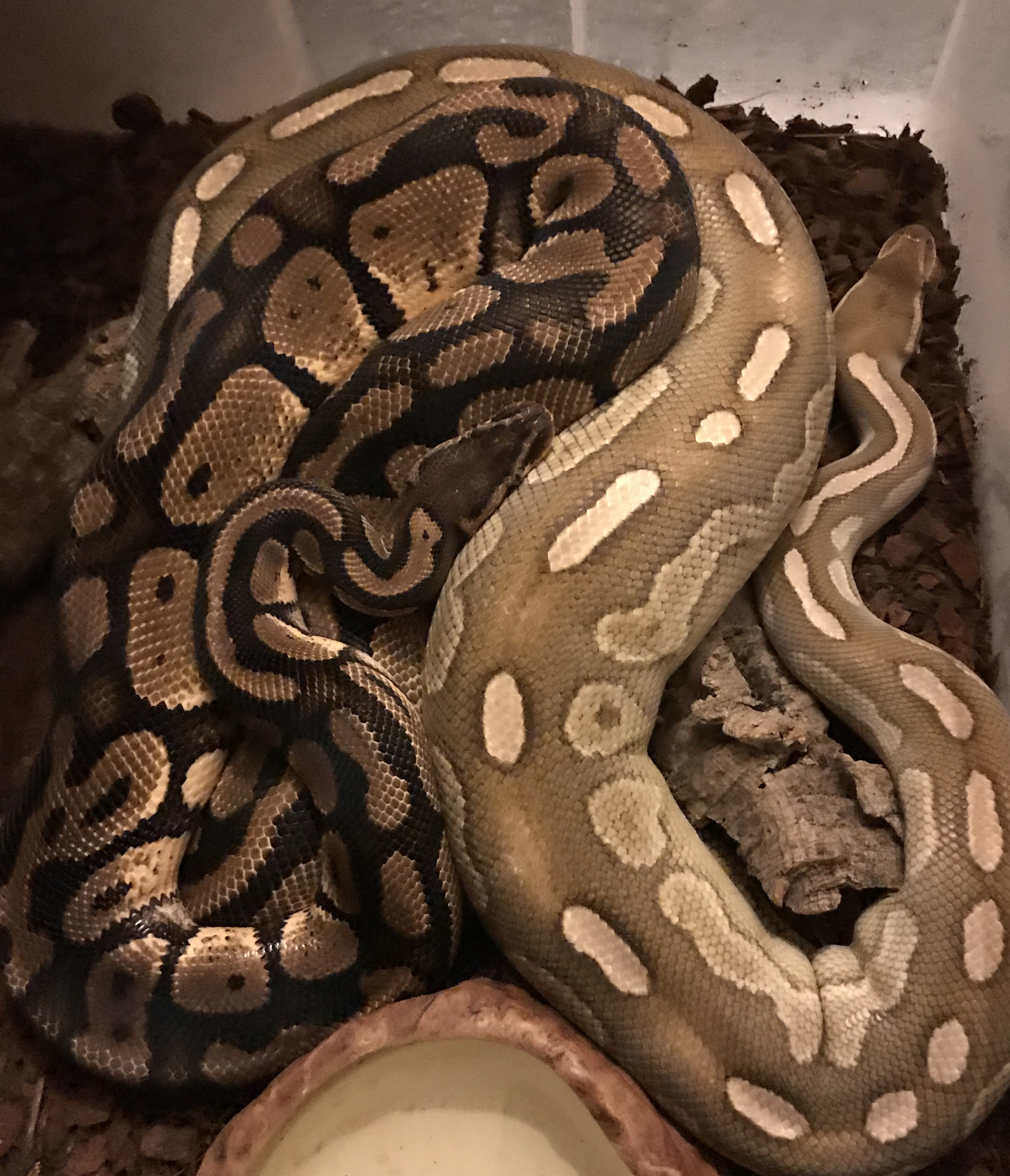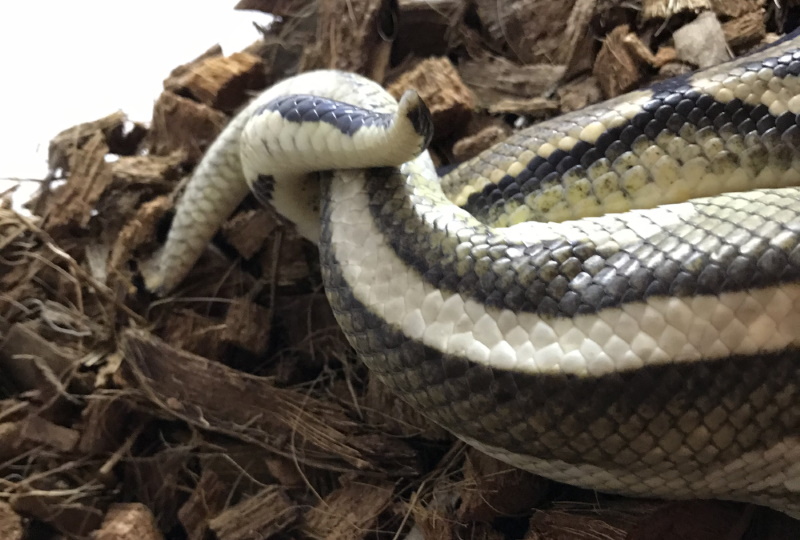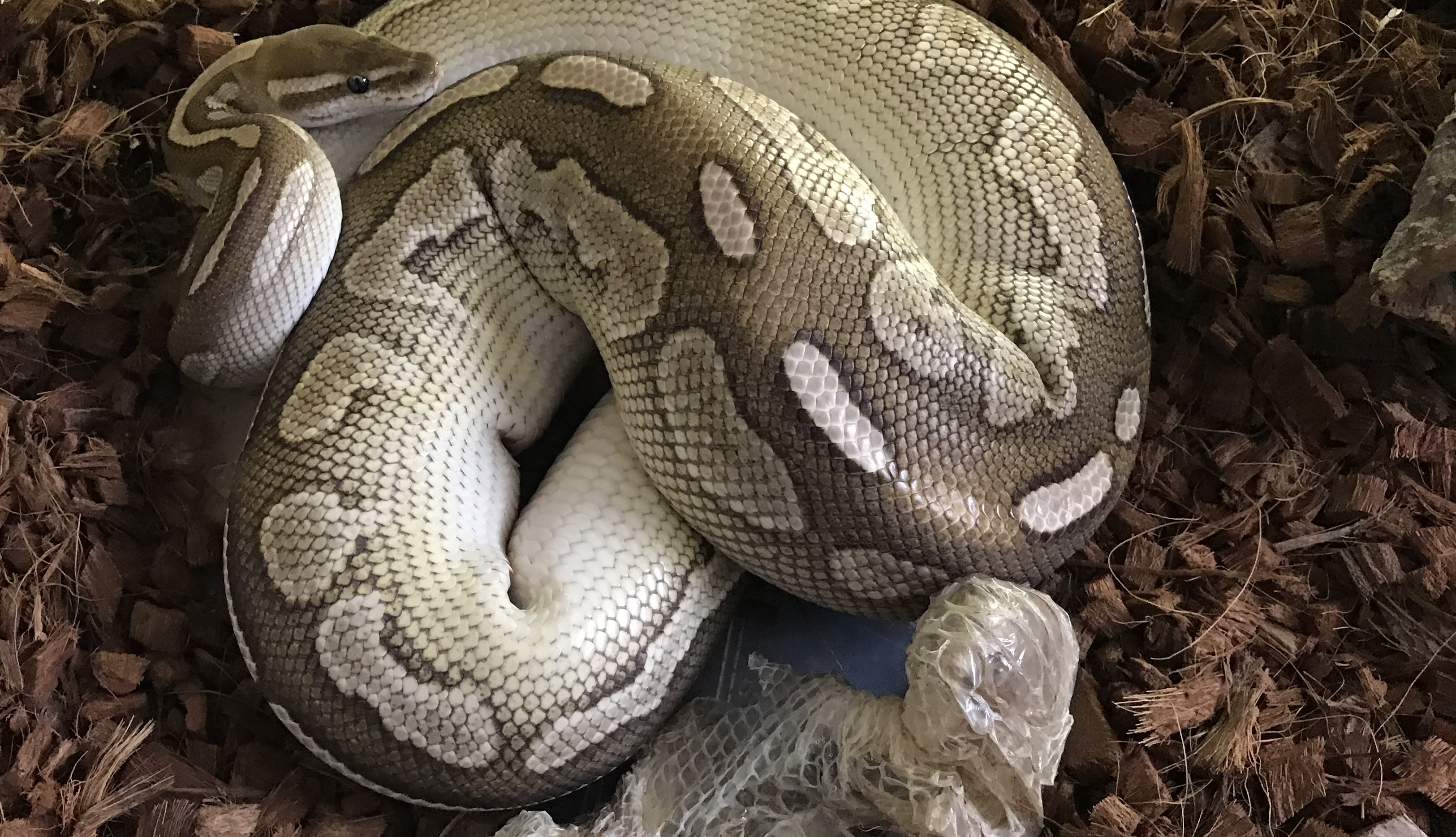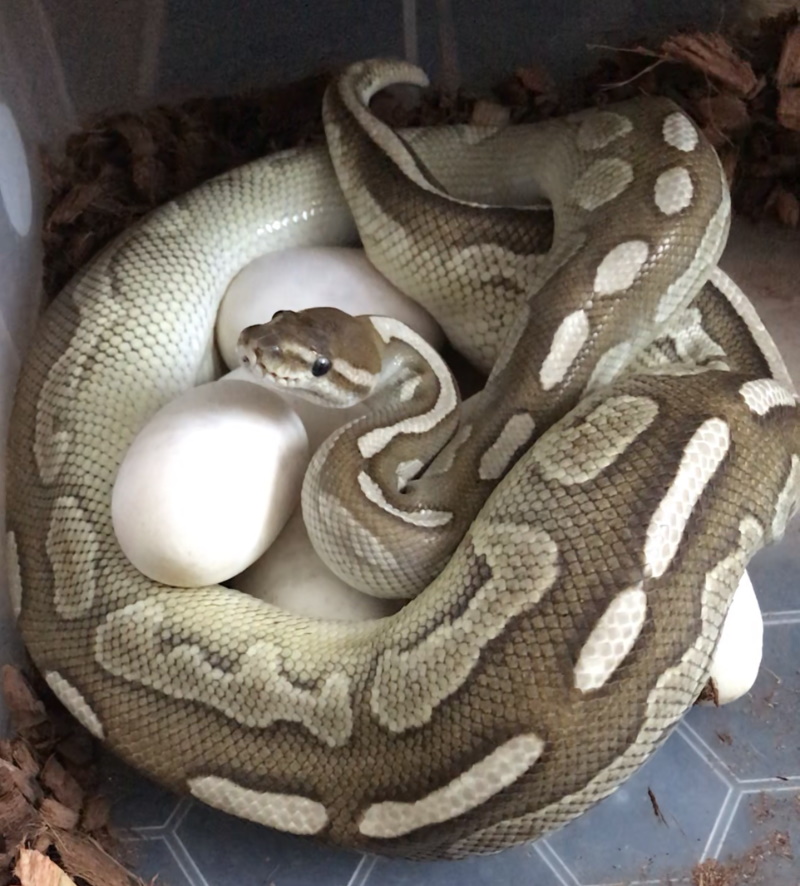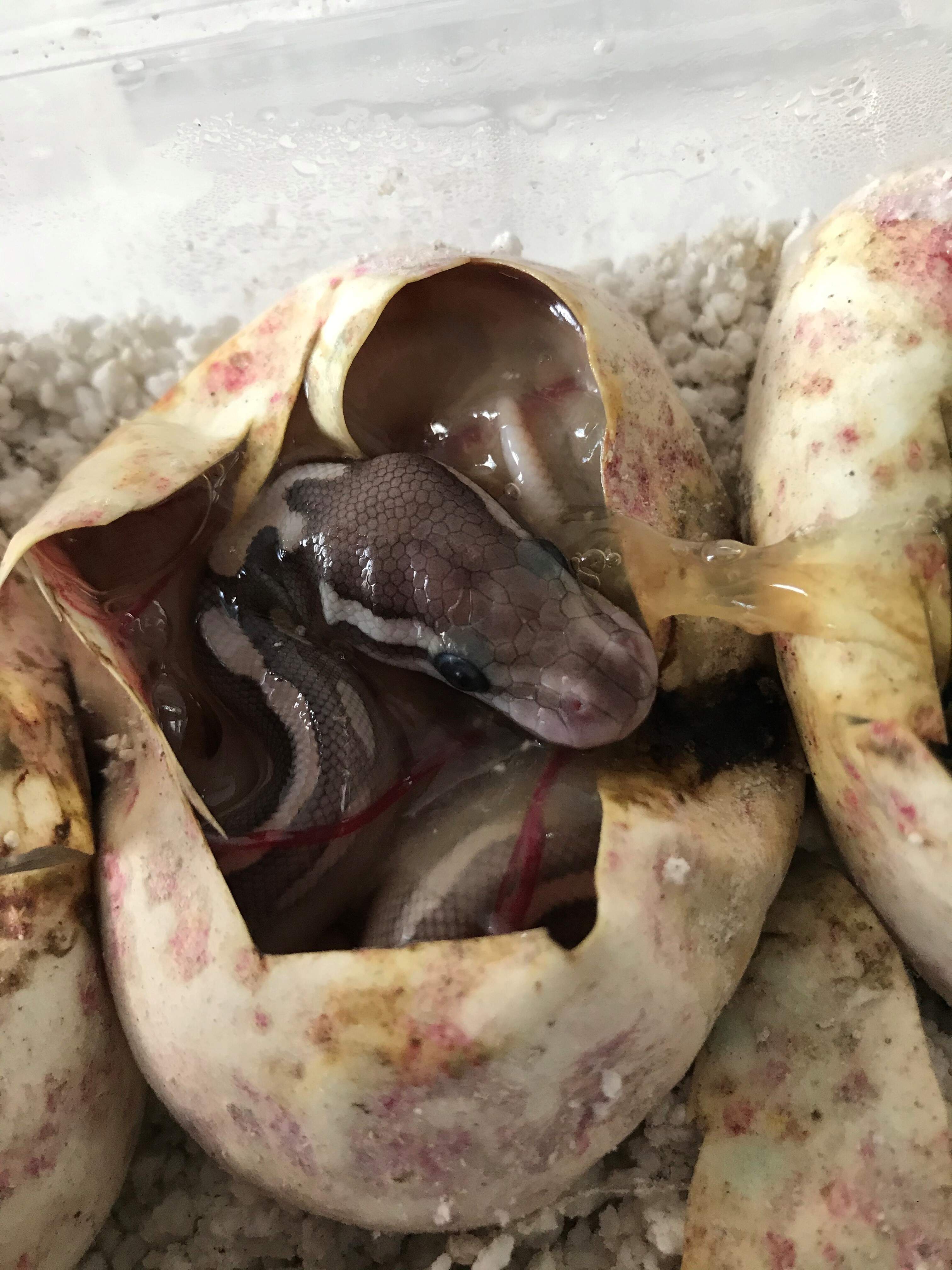Introduction to Breeding
First thing to note, breeding royal pythons isn’t particularly difficult, and with this in mind, it is up to you, the keeper/breeder to establish whether you have the capacity to care for the hatchlings, and have a market in which to sell them. Although breeding them is relatively easy, great care and responsibility needs to be taken when choosing to breed royal pythons. On average, a female will lay between 6 and 12 eggs per season, leaving you with a lot of hatchlings to provide enclosures, food and care.
Sexing
Popping
For young specimen, the easiest and safest way to sex them is “popping”. Popping is the process everting the animal’s sexual organs to determine the sex. Male Royal Pythons have inverted hemipenes located below the cloaca inside the tail. When we “pop” a male, the hemipenes will be everted and indicate that it is in fact a male. Females do not possess this sexual organ so no hemipenes will be present when popping. Females posses a scent gland here, so when you pop them, no hemipenes will be everted, but you can generally see the scent gland. The scent gland is usually pink / white in colour with tiny red blood vessels.
Great care is needed when popping an animal as too much pressure, or pressure in the wrong place can damage your snake. It is always best to have an experienced breeder or reptile keeper show and teach you how to use this method before attempting this yourself.
Probing
The most effective way to sex a Royal Python is by probing. Probing isn’t an acceptable method for small snakes as their under-developed sexual organs can often be too fragile. Probing is best used on fully mature snakes. Probing is the process of inserting a small probe under the cloaca, and down into the sexual organ to determine the sex. The probe will travel further in a male as the probe is entering the inverted hemipene. The probe distance for a male is roughly between 9-15 subcaudal scales. Females probe much more shallow, usually the distance of 1-5 subcaudal scales.
Probing should never be attempted without the training from a well experienced breeder or reptile keeper. Too much pressure, the absence of lubricant or incorrect sized equipment can all be a potential harm to your animal.
Feeding
Food is an important factor when breeding. Once the breeding season has started, we begin offering smaller prey items to our females, but on a more frequent basis. This assures the females that there is plenty of food available for her to continue building follicles, incubate her eggs, and for the young to feed on once they’ve hatched. Females can go food crazy throughout the breeding season! Our males stick to their original feeding schedule, but often they will go off food whilst in “breeding mode”. Pay close attention to their weight and condition at this time, as it isn’t unheard of for males to “breed themselves to death”. If your male is looking fatigued or losing weight, it is important to remove him from your breeding plans and concentrate on aiding his recovery.
Temperatures - Day / Night Cycle
Our breeding season runs from November to April. Royal pythons can be bred all year round, but we find that replicating a breeding season works best for several reasons. Here in the UK, we have very distinct seasons, giving us longer cooler nights throughout the winter period, giving us a natural temperature drop, and this alone can give you success when trying to breed. We aim to reduce our hot spot temperatures over-night, to about 29°c / 30°c, and increase these to 32°c/33°c throughout the day, but again, this is how we have found success, but isn’t entirely necessary. These small drops in temperature can trigger a breeding response from your snakes. We also make a change to the day/night cycle, offering longer nights and shorter days. We set our light timers to 8 hour days, and 16 hour nights. Again, this is just another trigger we have found helps promote breeding behaviour.
Pairing - Courtship
On the 1st November, we begin making the changes to the temperatures and the day/night cycle as described above. This is also the first day in which we begin pairing our adults, removing the males from their enclosures, and introducing them to the females. The males should be left no longer than 3 days in the female’s enclosure. Once copulation has been observed, we remove the male and return him to his own enclosure, and offer food on the next scheduled feeding day. We repeat this process every fortnight providing our males are accepting food, and their conditioning is good. Pairing only stops once an ovulation has been witnessed (more on this later). Courtship can often be witnessed almost immediately, but it isn’t uncommon for some pairs to take their time. We give each pair a 3 day opportunity to lock which is usually enough time. Females are especially attractive just after shedding as this is when she releases her sex pheromone to which males will respond by chasing and rubbing against her. Males also use their vestigial spurs to tickle the female. When females are feeling receptive to mating, she will lift her tail and rub her scent around the enclosure.
Copulation (Locking)
Locking is the term used for the act of copulation, or snake sex. When the snakes have exhibited the courting behaviour, this is now when you may witness a lock. The two snakes will lay the lower parts of their bodies side-by-side, the female will turn her cloaca to one side, and the male will insert one of his hemipenes. Snakes can remain locked for over 24 hours, so leave them be, and just make quiet regular checks. Once they have unlocked, return the male to his enclosure and offer food on the next scheduled day. Again, we repeat this process every 2 weeks until ovulation. Well done guys… you’re breeding Royal Pythons.
Female Behaviour
If this is your first time breeding, your female can now begin exhibiting unusual behaviour, but some of these can be great signs that your breeding is a success, and can also indicate how close to eggs you are. If the above steps are inconsistent, the female can reabsorb her follicles leaving you without a clutch of eggs. The increased feeding schedule, temperature drops, day/night cycle and the introduction of a male need to be consistent to ensure your female doesn’t reabsorb them.
When a female begins to build follicles, she can often seek cooler temperatures and wrap her body around her water bowl. She may also lay with her belly up off of the substrate. This can be shocking when you first see it, but stay calm… it’s normal for a breeding female. There is some speculation that this is to provide local thermoregulation to the ovaries, but this is still unproven.
As the ovarian development progresses, physical changes to your female’s appearance will become obvious too. Breeders often refer to this as “building”. This can last for a few weeks prior to ovulation. Some females can appear to have a kinked lower body, and often she will appear to have some temporary side deviation which breeders call “tail suck”. Closer to ovulation, your female may also appear lighter and brighter in colour which breeders refer to as “glowing”. Some females may exhibit all or none of the above changes, but neither situation means you have or haven’t been successful.
The next thing to look out for now is an ovulation. When this has been witnessed, you’re now guaranteed some eggs! This is now the best time to pair her with a male. Don’t worry, if this isn’t possible, your female will have retained sperm from previous pairings, but pairing at this time can certainly up your odds of getting perfect clutch of pearly whites. So, what are we looking for? When a female ovulates, the bottom half of her body will swell to an incredible size. It may look like she’s swallowed a drinks can or extra-large rat. This physical change can last for up to 12 hours, and following this she can reduce in size, often even smaller than the size prior to ovulation. Females may now begin to refuse food, but don’t worry, this is normal.
Shedding
Roughly 15 days after her ovulation, your female will go into a pre lay shed. This is just like a normal shed cycle, but this one is significant. Once your female has shed out, your clutch of eggs will land in around 20 – 40 days time. It is now common to find your female seeking warmer temperatures. It is recommended that you begin preparing a nest box for your female to enter and lay her eggs. Preparation of the incubator is also recommended.
Egg Laying
So, you’ve made the necessary changes to the temperatures, day/night cycle, feeding schedule. You’ve been introducing males regularly. You’ve seen some behavioural and physical changes, an ovulation, a pre lay shed… well guess what… it’s time for eggs. Your female will now begin looking for somewhere warm and humid to lay her eggs. The female will now begin laying her eggs in a pile. The number of eggs can vary from somewhere between 4 – 12 eggs, on average 7. Fertile eggs will be whiteish in colour, soft and chalky. The eggs will adhere to each other forming a nice little pile which the female will wrap around and incubate. Eggs known as “slugs” are also quite common. These are just unfertile eggs that are often yellow/orange in colour, and usually smaller than the others. These can just be discarded and removed from the clutch.
Removing the Eggs
Maternal incubation is possible, but not advisable. When the mother is allowed to incubate her eggs, she will sit on her clutch for 60+ days with little chance of taking food. The production of these eggs will have taken its toll on the female, so it would be beneficial for her to now begin feeding again. For this reason, we choose to remove the clutch off eggs and artificially incubate them. Now, this is the fun part! Females will be very protective over their clutch, so there’s a high chance of you receiving a bite. You can use a snake hook to manipulate the female’s direction, and carefully remove the rest of her body from the clutch. Once the eggs have been removed, it’s now time to get them in the incubator. At this point, the female now needs some after-care. The female is now bathed with a scent free soap to remove the smell if the eggs. Her entire enclosure is stripped from top to bottom and disinfected, removing and replacing all substrate. Fresh water and hides are now provided within the enclosure. It is important to remove the smell of the eggs as the female can still believe that she is maternally incubating her clutch and will continue to refuse food for up to 60 days.
Incubation
There are many ways to incubate eggs, and no one way is better than the other. Something as simple as a polystyrene box can be fitted with heat pads on a thermostat. Larger breeders convert glass front fridges into incubators. There are also a range of affordable reptile incubators on the market. The eggs cannot be placed directly into the incubator, and some preparation is needed. We use an appropriately sized plastic air-tight tub to contain the eggs, with a water retentive substrate such as Hatchrite or Vermiculite. Water is added to the substrate until it is damp and clumps together in the hand. This is important… the substrate should be damp, not wet! If any eggs have separated from the clutch, these will now need "candling". This is the process of shining a torch against the egg in a dark room to locate the embryo. The embryo needs to be positioned at the top of the egg and marked. If you plan on separating all of the eggs, it is a good idea to candle the whole clutch, and position the eggs so the network of veins and embryo are positioned at the top. The eggs are now placed on to the substrate, the lid placed back on the tub, and the tub is placed into the incubator and left for 60 days. It is recommended to remove the lid of the airtight box at least once per week to offer some air exchange. The optimum temperature for incubating Royal Python eggs is 88°f. Consistently incubating at this temperature will mean your eggs will begin hatching around day 55-60. Lower temperatures are fine, but the incubation time will be increased. Temperatures above 90°f will have a sooner hatch date, but the hatchlings will often have health issues and deformities. Humidity should be kept at 100% during incubation. This is easily achieved providing your egg box and incubator is airtight. If you witness water droplets forming on top of the eggs, there is no harm in dabbing them dry with paper towel.
Hatching
So, your eggs have been in the incubator for 60 days… what now? Well, if the incubation temperature has been consistent, the hatchlings may have begun “pipping”. Pipping is a term used when the hatchlings have begun making an opening in the eggs using their egg tooth. At this point, the hatchlings can be left to exit the eggs themselves. Usually, they will have completely left the eggs within a few days of pipping. Breeders also cut their eggs. Any time after day 55 is usually safe providing the temperatures have been consistent. A small pair of scissors are used to cut a small hole in the egg, and then the hatchling is left to exit within the next few days. Breeders generally do this to see what morphs or genetic combinations they have made. There is some argument as to which way is right. Cutting the eggs allow us to check on the hatchling’s safety. Sometimes a hatchling can get wound up in its own umbilical cord, and eventually drown in the egg fluid. Others say that its more natural to let the babies hatch on their own. There is no right or wrong way here, but if you are choosing to cut the eggs, please be careful and responsible about when and how you do it.



